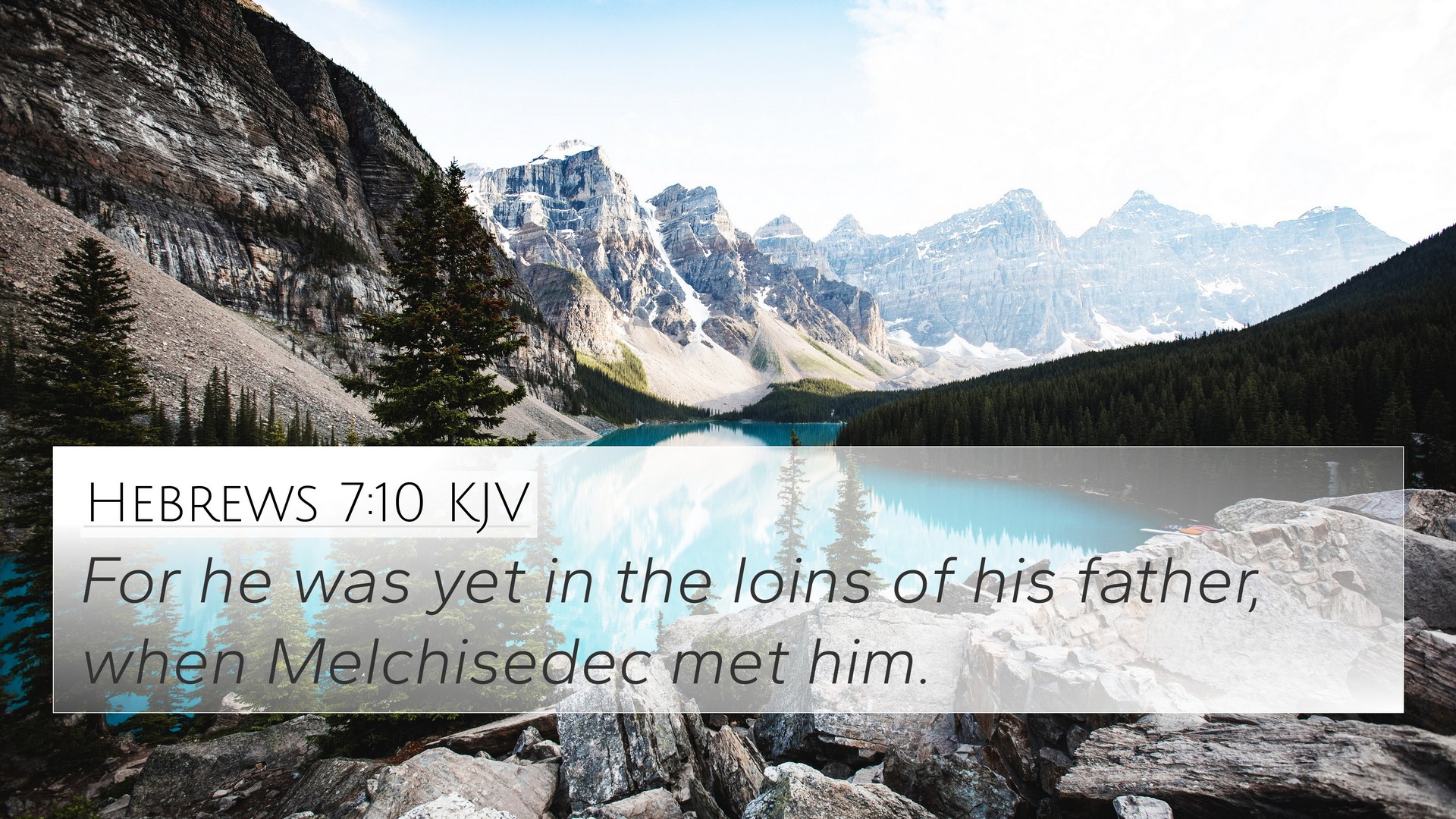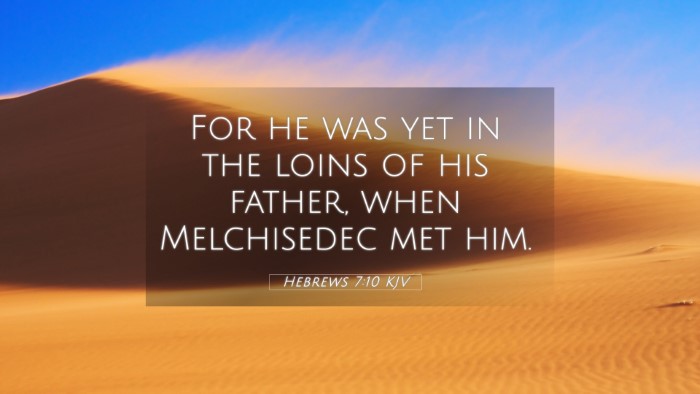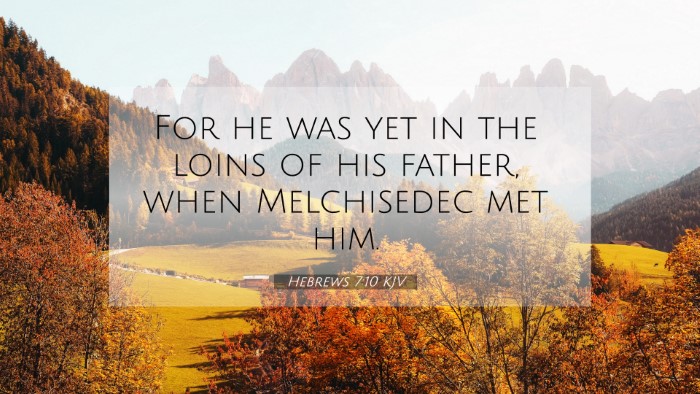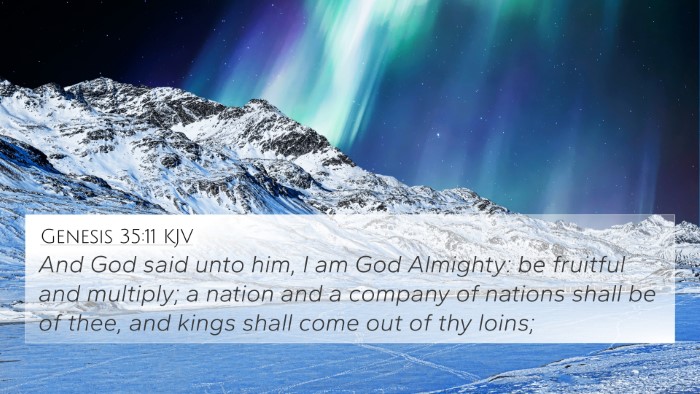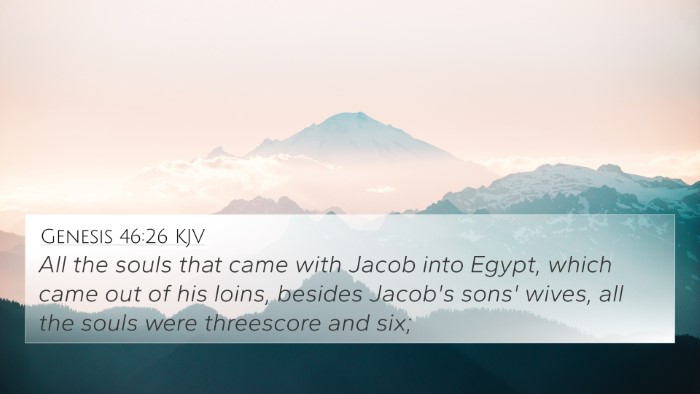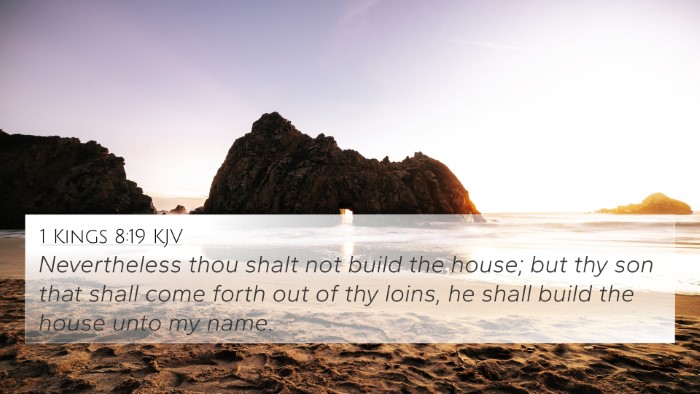Understanding Hebrews 7:10
Hebrews 7:10 states, “For he was yet in the loins of his father, when Melchisedec met him.” This verse refers to the mysterious figure of Melchisedec, who met Abraham and is considered a type of Christ, representing a priesthood that is eternal and superior to the Levitical priesthood. The implications of this verse reveal significant theological truths regarding the nature of priesthood and Christ's intercessory role.
Significance of Melchisedec
Commentators highlight several important elements of Melchisedec's character and his function:
- Type of Christ: Melchisedec is often viewed as a foreshadowing of Christ, signifying an eternal priesthood and kingly role.
- Royal Priesthood: He serves as both king of righteousness and king of peace, encapsulating the dual office that Christ fulfills.
- No Genealogy: The lack of recorded genealogy elevates Melchisedec’s priesthood above the Levitical line, which is crucial for understanding Jesus's qualifications as a priest.
Theological Implications
The text assures believers of Christ's unique status as the ultimate High Priest:
- Superior Mediator: Christ’s priesthood brings a better hope, as He mediates based on His sacrifice rather than animal offerings.
- Enduring Priesthood: Just as Melchisedec has no recorded end to his priesthood, Christ’s priestly office is eternal, providing assurance of continual intercession.
- New Covenant Theology: This foreshadowing supports the New Covenant, where Jesus fulfills the roles of both King and Priest for His followers.
Cross-References and Related Scriptures
This verse connects significantly with several other scriptures that enhance its meaning:
- Genesis 14:18-20: The actual meeting of Abraham and Melchisedec.
- Psalm 110:4: God declares that Christ is a priest forever in the order of Melchisedec.
- Hebrews 5:6-10: Discusses Jesus’s priesthood and its establishment through His suffering.
- Hebrews 6:20: Jesus entered as a forerunner on our behalf, made a High Priest forever.
- Romans 5:1-2: Describes the peace we have through faith by our High Priest.
- 1 Peter 2:9: Believers are a chosen race, a royal priesthood, indicating the shared nature of this priestly identity.
- Revelation 1:6: Christ has made us to be a kingdom and priests to serve God.
Connections Between Bible Verses
Understanding Hebrews 7:10 involves recognizing its thematic connections with other parts of scripture:
- Link to Abraham: The reference to Abraham highlights the foundational role of faith and foreshadows the new covenant initiated by Jesus.
- Thematic Cross-Referencing: This verse reflects the theme of faith versus law that runs throughout much of Hebrews.
- Inter-Biblical Dialogue: The connections between Old and New Testament teachings provide a rich tapestry of understanding regarding God's covenantal promises.
Bible Verse Parallels and Their Importance
When conducting a comparative Bible verse analysis, the following themes emerge:
- Comparative Study: By comparing Melchisedec’s priesthood to Aaron’s, one sees the transition from law to grace.
- Rooted in Historical Context: Acknowledging the historical context of Melchisedec within the Hebrew scriptures is essential for drawing parallels with Christ.
- The Life of Faith: The faith of Abraham places emphasis on individual trust in God's promise, reflected in how believers relate to Christ as High Priest.
Tools for Biblical Cross-Referencing
To better understand and explore these themes, the following tools and methodologies can enhance your study:
- Bible Concordance: Utilize a concordance for cross-referencing key terms and names.
- Bible Cross-Reference Guide: A good guide will help identify links between different Biblical texts effectively.
- Cross-Reference Bible Study: Engage in study methods that allow for deep exploration of connections and theological implications.
- Bible Chain References: Trace themes and topics through chain reference systems to see the broader context.
Conclusion
Hebrews 7:10 serves as a cornerstone for understanding the identity and work of Christ as our High Priest. The connections established through cross-referencing highlight the coherence of Scripture and reinforce the belief that Jesus's priesthood fulfills and transcends the old order. For those seeking deeper interpretations, utilizing tools for cross-referencing and examining the relationship between verses can yield profound insights into the faith's richest truths.
